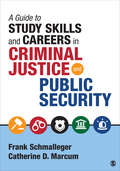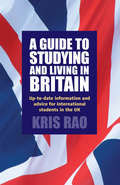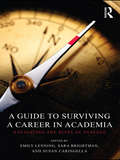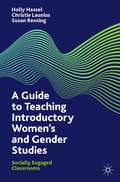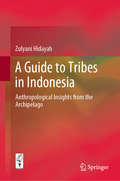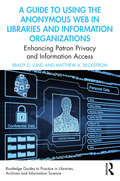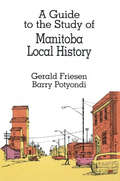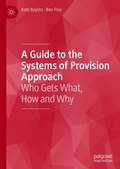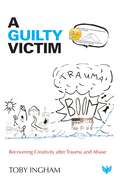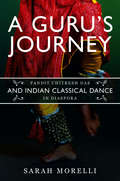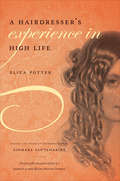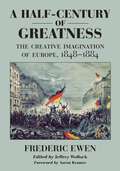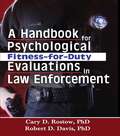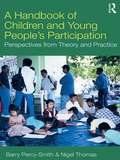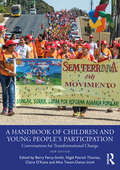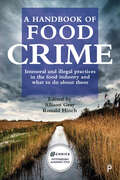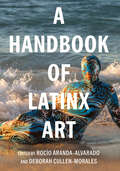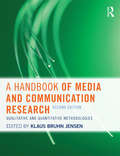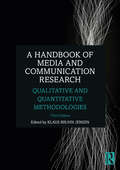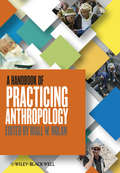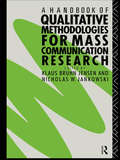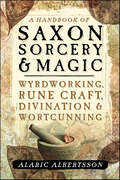- Table View
- List View
A Guide to Study Skills and Careers in Criminal Justice and Public Security: Cox: Juvenile Justice 9e + Schmalleger: A Guide To Study Skills And Careers In Criminal Justice And Public Security
by Catherine D. Marcum Professor Frank A. SchmallegerA Guide to Study Skills and Careers in Criminal Justice and Public Security is the ultimate how-to resource for success in the study of criminal justice. Renowned author Frank Schmalleger, who has over 40 years of field experience, has teamed up with researcher and educator Catherine D. Marcum to introduce students to the field of criminal justice, break down its many components, and describe a variety of employment opportunities available to criminal justice graduates. Students will learn how to effectively approach the study of criminal justice; communicate successfully with professors, peers, and potential employers; choose classes that will assist with career goals; develop good study habits and critical thinking skills; and write effectively in criminal justice. Additionally, as their academic careers advance, students will gain insights into how to best prepare for successful careers.
A Guide to Study Skills and Careers in Criminal Justice and Public Security: Cox: Juvenile Justice 9e + Schmalleger: A Guide To Study Skills And Careers In Criminal Justice And Public Security
by Catherine D. Marcum Professor Frank A. SchmallegerA Guide to Study Skills and Careers in Criminal Justice and Public Security is the ultimate how-to resource for success in the study of criminal justice. Renowned author Frank Schmalleger, who has over 40 years of field experience, has teamed up with researcher and educator Catherine D. Marcum to introduce students to the field of criminal justice, break down its many components, and describe a variety of employment opportunities available to criminal justice graduates. Students will learn how to effectively approach the study of criminal justice; communicate successfully with professors, peers, and potential employers; choose classes that will assist with career goals; develop good study habits and critical thinking skills; and write effectively in criminal justice. Additionally, as their academic careers advance, students will gain insights into how to best prepare for successful careers.
A Guide to Studying and Living in Britain: Up-to-date Information And Advice For International Students In The Uk
by Kris RaoEvery year more than 270,000 students from all around the world come to study in the UK - and the number is growing by 10 per cent a year. At present, most students coming to the UK have to rely on information from their friends, and brief leaflets and booklets supplied by universities. This indispensable guide tells students all they need to know about Britain's higher education system: the application process, funding, immigration controls, health service, accommodation, study methods and employment opportunities, as well as university life, British customs and habits, and lots of other information on day to day living in the UK.
A Guide to Studying and Living in Britain: Up-to-date Information and Advice for International Students in the UK
by Kris RaoEvery year more than 270,000 students from all around the world come to study in the UK - and the number is growing by 10 per cent a year. At present, most students coming to the UK have to rely on information from their friends, and brief leaflets and booklets supplied by universities. This indispensable guide tells students all they need to know about Britain's higher education system: the application process, funding, immigration controls, health service, accommodation, study methods and employment opportunities, as well as university life, British customs and habits, and lots of other information on day to day living in the UK.
A Guide to Surviving a Career in Academia: Navigating the Rites of Passage
by Emily LenningNavigating an academic career is a complex process – to be successful requires mastering several 'rites of passage.' This comprehensive guide takes academics at all stages of their career through a journey, beginning at graduate school and ending with retirement. A Guide to Surviving a Career in Academia is written from a feminist perspective, and draws on the information offered in workshops conducted at national meetings like the American Society of Criminology and the Society for the Study of Social Problems. Through the course of the book, an expert team of authors guide you through the obstacle course of finding effective mentors during graduate school, finding a job, negotiating a salary, teaching, collaborating with practitioners, successfully publishing, earning tenure and redressing denial and, finally, retirement. This collection is a must read for all academics, but especially women just beginning their careers, who face unique challenges when navigating through these age-old rites of passage.
A Guide to Teaching Introductory Women’s and Gender Studies: Socially Engaged Classrooms
by Christie Launius Holly Hassel Susan RensingThis book provides a practical, evidence-based guide to teaching introductory Women's and Gender Studies courses. Based on the findings of a Scholarship of Teaching and Learning project that analyzed 72 Intro students’ written work, the authors equip instructors with key principles that can help them adapt their pedagogy to a range of classroom environments. By putting student learning at the center of course design, the authors invite readers to reflect on their own investments in and goals for the introductory course. The book also draws on the authors’ combined decades of teaching experience, and aims to help instructors anticipate the emotional, intellectual, and interpersonal challenges and rewards of teaching and learning in the introductory WGS course. Chapters focus on course design, including identifying desired learning outcomes (in terms of course content, skills, and dispositions or habits of mind); choosing course materials; pedagogical activities; and assessing student learning. This book will be an invaluable resource for experienced WGS instructors and those seeking or planning to teach it for the first time, including graduate students and high school teachers.
A Guide to Therapeutic Child Care: What You Need to Know to Create a Healing Home
by Autumn Roesch-Marsh Ruth Emond Laura SteckleyA Guide to Therapeutic Child Care provides an easy to read explanation of the secrets that lie behind good quality therapeutic child care. It describes relevant theories, the 'invisible' psychological challenges that children will often struggle with and how to develop a nurturing relationship and build trust. Combining advice with practical strategies, the book also provides specific guidance on how to create safe spaces (both physical and relational) and how to aid the development of key social or emotional skills for children which may be lacking as a result of early trauma. Written with input from foster carers, the book is an ideal guide for residential child care workers, foster carers, kinship carers, social workers and new adoptive parents.
A Guide to Tribes in Indonesia: Anthropological Insights from the Archipelago
by Zulyani HidayahThis encyclopedia provides a comprehensive overview of the traditions, cultures, kinship norms, and other significant cultural aspects of the tribes, or otherwise named ethnic groups, of Indonesia, by an Indonesian anthropologist. The entries are supported by illustrations drawn by the late author himself, and are also accompanied by maps indicating the geographic locations and distributions of each tribe throughout the vast archipelago. Originally written and published in Bahasa Indonesian, the text has been translated into English and revised to feature up-to-date information. In showcasing the extent of diversity and the distinctiveness of the numerous tribal cultures in Indonesia, the volume presents itself as an important academic reference in Indonesian anthropology and ethnography studies, now finally available to global readership. Intended as a short work of reference, it will be indispensable to students and scholars researching Indonesia from anthropological, sociocultural, and ethnographic perspectives.
A Guide to Using the Anonymous Web in Libraries and Information Organizations: Enhancing Patron Privacy and Information Access (Routledge Guides to Practice in Libraries, Archives and Information Science)
by Brady D. Lund Matthew A. BeckstromA Guide to Using the Anonymous Web in Libraries and Information Organizations provides practical guidance to those who are interested in integrating the anonymous web into their services. It will be particularly useful to those seeking to promote enhanced privacy for their patrons. The book begins by explaining, in simple terms, what the anonymous web is, how it works, and its benefits for users. Lund and Beckstrom also explain why they believe access to the anonymous web should be provided in library and information organizations around the world. They describe how to provide access, as well as educate library users on how to utilize the anonymous web and navigate any challenges that might arise during implementation. The authors also encourage the development of library policies that guide appropriate conduct and filter content, where appropriate, in order to deter illegal activity. A Guide to Using the Anonymous Web in Libraries and Information Organizations reminds us that libraries and other information providers have a duty to educate and support their communities, while also preserving privacy. Demonstrating that the anonymous web can help them to fulfil these obligations, this book will be essential reading for library and information professionals working around the world.
A Guide to the Study of Manitoba Local History
by Gerald Friesen Barry PotyondiLocal history buffs, students, teachers, and armchair historians will find a wealth of information and practical advice in this guide to the study of local history. The authors explore some of the most fruitful areas of research in such themes as the environment, population, transportation and communication, agriculture, politics, social and family life. In five appendices they provide more detailed information for the determined researcher. Specific advice is given on compiling a community archive or data base, and on publishing a local history. An extensive bibliography and a guide to local archives complete the book.
A Guide to the Systems of Provision Approach: Who Gets What, How and Why
by Ben Fine Kate BaylissUnderstanding consumption requires looking at the systems by which goods and services are provided – not just how they are produced but the historically evolved structures, power relations and cultures within which they are located. The Systems of Provision approach provides an interdisciplinary framework for unpacking these complex issues. This book provides a comprehensive account of the Systems of Provision approach, setting out core concepts and theoretical origins alongside numerous case studies. The book combines fresh understandings of everyday consumption using examples from food, housing, and water, with implications for society’s major challenges, including inequality, climate change, and prospects for capitalism. Readers do not require prior knowledge across the subject matter covered but the text remains significant for accomplished researchers and policymakers, especially those interested in the messy real world realities underpinning who gets what, how, and why across public and private provision in global, national, and historical contexts.
A Guilty Victim: Recovering Creativity after Trauma and Abuse
by Toby InghamThe complex nature of grooming and abuse is often simplified by those who do not understand it and are left wondering why the victim allowed it to happen. A Guilty Victim challenges that misconception and explains how and why abuse continues and the impact it leaves on the victim's life. It explains that we remain trapped in situations not because there is something wrong with us, but because of things that have happened to us. It is unusual to have permission to be able to illustrate the process of psychotherapy in action. William Smith bravely suggested his story be told to help at-risk children by showing adults how to recognise the warning signs in children's behaviour. His long journey to recovery is also an inspiration to others struggling to come to terms with childhood trauma. The book is presented in five parts. The first details the start of William's psychotherapy. Part II takes us back to William's childhood, a time of traumatic experiences, culminating in him being sent away from England to a Catholic boarding school in Ireland where a priest exploits his vulnerability. Part III continues his life story past school to a life dominated by work and heavy drinking, and marked by his first suicide attempt. His fortunes change when he meets Meg and finds some stability. Years later, when his youngest child leaves home and he has time on his hands, his suicidal feelings return. It is at this point he starts psychotherapy. The penultimate part focuses on William's creativity and his innovative illustrated timeline of his life. This creative project is a key part of his recovery. Once that is completed, his psychotherapy starts to come to an end, which is the final part of the book. A Guilty Victim is a human story that will appeal to anyone with an interest in understanding trauma, psychotherapy, wellness and mental health. It is especially relevant to people with responsibility for safeguarding children and vulnerable people. It is a counter to a market saturated by vignettes, fictionalised stories, and life hacks.
A Guru’s Journey: Pandit Chitresh Das and Indian Classical Dance in Diaspora (Music in American Life)
by Sarah MorelliAn important modern exponent of Asian dance, Pandit Chitresh Das brought kathak to the United States in 1970. The North Indian classical dance has since become an important art form within the greater Indian diaspora. Yet its adoption outside of India raises questions about what happens to artistic practices when we separate them from their broader cultural contexts. A Guru's Journey provides an ethnographic study of the dance form in the San Francisco Bay Area community formed by Das. Sarah Morelli, a kathak dancer and one of Das's former students, investigates issues in teaching, learning, and performance that developed around Das during his time in the United States. In modifying kathak's form and teaching for Western students, Das negotiates questions of Indianness and non-Indianness, gender, identity, and race. Morelli lays out these issues for readers with the goal of deepening their knowledge of kathak aesthetics, technique, and theory. She also shares the intricacies of footwork, facial expression in storytelling, and other aspects of kathak while tying them to the cultural issues that inform the dance.
A Hairdresser's Experience in High Life
by Eliza PotterHere is the first fully annotated edition of a landmark in early African American literature--Eliza Potter's 1859 autobiography,A Hairdresser's Experience in High Life. Potter was a freeborn black woman who, as a hairdresser, was in a unique position to hear about, receive confidences from, and observe wealthy white women--and she recorded it all in a revelatory book that delighted Cincinnati's gossip columnists at the time. But more important is Potter's portrait of herself as a wage-earning woman, proud of her work, who earned high pay and accumulated quite a bit of money as one of the nation's earliest "beauticians" at a time when most black women worked at the bottom of the socioeconomic ladder. Because her work offered insights into the private lives of elite white women, Potter carved out a literary space that featured a black working woman at the center, rather than at the margins, of the era's transformations in gender, race, and class structure. Xiomara Santamarina provides an insightful introduction to this edition that includes newly discovered information about Potter, discusses the author's strong satirical voice and proud working-class status, and places the narrative in the context of nineteenth-century literature and history.
A Half-Century of Greatness: The Creative Imagination of Europe, 1848-1884
by Frederic EwenChoice Outstanding Academic Title for 2008A Half-Century of Greatness paints a vivid and dramatic picture of the creative thought of mid- to late nineteenth century Europe and the influence of the unsuccessful revolutions of 1848. It reveals often unexpected links between novelists, poets, and philosophers from England, Germany, Austria, Hungary, Russia, and Ukraine—especially Dickens, Carlyle, Mill, the Brontës, and George Eliot; Hegel, Strauss, Feuerbach, Marx, Engels, Wagner, and several German poets; the Hungarian poet Sándor Petöfi; Gogol, Dostoevsky, Bakunin, and Herzen in Russia, and the great Ukrainian poet Shevchenko. Ewen goes on to trace the transition from Romanticism to Victorianism, or what he calls “the Victorian compromise”—the ascendancy of the middle class.The book was reconstructed and edited by Dr. Jeffrey Wollock from Ewen’s final manuscript. It includes the author's own reference citations throughout, a reconstructed bibliography, and an updated “further reading” list.This is Ewen’s last work, the long-lost companion to his Heroic Imagination. Together, these books present a panorama of the social, political, and artistic aspects of European Romanticism, especially foreshadowing and complementing recent work on the relation of Marxism to romanticism. Anyone interested in what Lukacs called “Romantic anticapitalism,”; who appreciates such books as Marshall Berman's Adventures in Marxism or E.P. Thompson's The Romantics (1997), will find Ewen’s work a welcome addition.
A Handbook for Psychological Fitness-for-Duty Evaluations in Law Enforcement
by Cary D. Rostow Robert D. DavisWhile some books about police psychology contain a chapter on the fitness-for-duty question, this is the first comprehensive publication focused exclusively on psychological fitness-for-duty evaluations (FFDEs) for law enforcement personnel. This handbook is ideal for professionals and for coursework designed to prepare individuals for careers as police or municipal officials, psychologists, students, behavioral science specialists, human rights advocates, and attorneys. A helpful glossary makes the book even more useful for students and those who do not have extensive academic or formal training in psychology or public administration. A Handbook for Psychological Fitness-for-Duty Evaluations in Law Enforcement describes in detail the mechanics of setting up a fitness-for-duty methodology and examines the effectiveness of FFDEs in law enforcement. You’ll find clear instructions for developing a FFDE system from the law enforcement executive’s viewpoint (valuable for attorneys, police psychologists, and civil service board members as well), and an extensive bibliography with particular emphasis on laws and cases that provide guidance to psychological and law enforcement professionals. Several appendices provide examples of documentation that can be used in the evaluation process. This book brings you reliable information on: legal precedents, with a review of legal cases (in language appropriate for law enforcement executives and psychologists) the interaction between police culture, psychological assessment, and therapy federal laws that impact FFDEs, including the HIPAA, the Americans with Disabilities Act, the Family Medical Leave Act and the Fair Credit Reporting Act case law and FFDEs, with emphasis on civil rights laws, labor issues, professional ethical dilemmas, and the psychologist as a potential expert witness the proper uses—and the misuses—of the FFDE approach police departmental civil liability and the role that the FFDE plays in addressing legal risks In addition, this book contains a succinct review of psychological testing (psychometrics), and the technicalities of employing a professional psychologist to determine the fitness of commissioned officers. A Handbook for Psychological Fitness-for-Duty Evaluations in Law Enforcement proposes a model law that could be used to improve the utility and effectiveness of FFDEs, and presents a forward-looking discussion of FFDE issues that may become controversial in the near future.
A Handbook of Children and Young People's Participation: Perspectives from Theory and Practice
by Nigel Thomas Barry Percy-SmithA Handbook of Children and Young People's Participation brings together key thinkers and practitioners from diverse contexts across the globe to provide an authoritative overview of contemporary theory and practice around children’s participation. Promoting the participation of children and young people – in decision-making and policy development, and as active contributors to everyday family and community life – has become a central part of policy and programme initiatives in both majority and minority worlds. This book presents the most useful recent work in children’s participation as a resource for academics, students and practitioners in childhood studies, children’s rights and welfare, child and family social work, youth and community work, governance, aid and development programmes. The book introduces key concepts and debates, and presents a rich collection of accounts of the diverse ways in which children’s participation is understood and enacted around the world, interspersed with reflective commentaries from adults and young people. It concludes with a number of substantial theoretical contributions that aim to take forward our understanding of children’s participation. The emphasis throughout the text is on learning from the complexity of children’s participation in practice to improve our theoretical understanding, and on using those theoretical insights to challenge practice, with the aim of realising children’s rights and citizenship more fully.
A Handbook of Children and Young People’s Participation: Conversations for Transformational Change
by Afua Twum-Danso Imoh Barry Percy-Smith Nigel Patrick Thomas Claire O’KaneThis new edition of A Handbook of Children and Young People’s Participation brings together work from research and practice to reflect on some of the key developments in the field since the first edition published in 2010. Subtitled ‘Conversations for Transformational Change’, the collection focuses on both ongoing and new discourses that enable us to advance thinking and practice to better understand what it means for participation to be transformational. Featuring all new content, it explores the developments that have been achieved in theory and practice in the last decade as well as the challenges and, indeed, the limitations of dominant participation approaches with children and young people in achieving genuine societal transformation. A key feature of the Handbook is the inclusion of young people as co-authors in many of the chapters. Foregrounding aspects of participation as experienced by diverse groups of children and young people, the book especially illuminates the experiences and perspectives of participation relating to groups of children who face particular challenges, such as displaced children and children living with disabilities and young people from indigenous groups in a range of contexts. The broad spectrum of debates that the text covers will be invaluable in challenging and transforming thinking and practice for a wide range of scholars, practitioners, activists and young people themselves. It will additionally be suitable for use on a wide range of courses including childhood and youth studies, sociology, law, political studies, community development, development studies, children’s rights, citizenship studies, education and social work.
A Handbook of Food Crime: Immoral and Illegal Practices in the Food Industry and What to Do About Them
by Allison Gray and Ronald HinchFood today is over-corporatized and under-regulated. It is involved in many immoral, harmful, and illegal practices along production, distribution, and consumption systems. These problematic conditions have significant consequences on public health and well-being, nonhuman animals, and the environment, often simultaneously. In this insightful book, Gray and Hinch explore the phenomenon of food crime. Through discussions of food safety, food fraud, food insecurity, agricultural labour, livestock welfare, genetically modified foods, food sustainability, food waste, food policy, and food democracy, they problematize current food systems and criticize their underlying ideologies. Bringing together the best contemporary research in this area, they argue for the importance of thinking criminologically about food and propose radical solutions to the realities of unjust food systems.
A Handbook of Latinx Art (Documents of Twentieth-Century Art)
by RocíO Aranda-Alvarado and Deborah Cullen-MoralesA curated selection of key texts and artists’ voices exploring US Latinx art and art history from the 1960s to the present. A Handbook of Latinx Art is the first anthology to explore the rich, deep, and often overlooked contributions that Latinx artists have made to art in the United States. Drawn from wide-ranging sources, this volume includes texts by artists, critics, and scholars from the 1960s to the present that reflect the diversity of the Latinx experience across the nation, from the West Coast and the Mexican border to New York, Miami, and the Midwest. The anthology features essential writings by Mexican American, Puerto Rican, Cuban American, Dominican American, and Central American artists to highlight how visionaries of diverse immigrant groups negotiate issues of participation and belonging, material, style, and community in their own voices. These intersectional essays cut across region, gender, race, and class to lay out a complex emerging field that reckons with different histories, geographies, and political engagements and, ultimately, underscores the importance of Latinx artists to the history of American art.
A Handbook of Media and Communication Research: Qualitative and Quantitative Methodologies
by Klaus Bruhn JensenA Handbook of Media and Communication Research presents qualitative as well as quantitative approaches to the study of media and communication, integrating perspectives from both the social sciences and the humanities. Taking methodology as a strategic level of analysis that joins practical concerns with theoretical issues, the Handbook offers a comprehensive and in-depth review of the field and a set of guidelines for how to think about, plan, and carry out media and communication studies in different social and cultural contexts. The second edition has been thoroughly updated with reference to the development of the internet, mobile, and other digital media. Each chapter addresses shifting configurations of established media organizations, media discourses, and media users in networked practices of communication. The introduction and one further chapter probe changing conceptions on mass and interpersonal, online and offline communication – in research as in everyday life. Three new chapters have been added to exemplify different forms of research employing multiple methods to study multiple media in multiple contexts. List of contributors: Klaus Bruhn Jensen, Barrie Gunter, Rasmus Helles, Annette Hill, Stig Hjarvard, Peter Larsen, Amanda Lotz, Graham Murdock, Horace Newcomb, Paddy Scannell, Lynn Schofield Clark, Kim Christian Schrøder
A Handbook of Media and Communication Research: Qualitative and Quantitative Methodologies
by Klaus Bruhn JensenThoroughly revised and updated, this third edition integrates perspectives from the social sciences and the humanities, focusing on methodology as a strategic level of analysis that joins practical applications with theoretical issues. The Handbook comprises three main elements: historical accounts of the development of key concepts and research traditions; systematic reviews of media organizations, discourses, and users, as well as of the wider social and cultural contexts of communication; and practical guidelines with sample studies, taking readers through the different stages of a research process and reflecting on the social uses and consequences of research. Updates to this edition include: An overview of the interrelations between networked, mass, and interpersonal communication. A new chapter on digital methods. Three chapters illustrating different varieties of media and communication research, including industry–academic collaboration and participatory action research. Presentation and discussion of public issues such as surveillance and the reconfiguration of local and global media institutions. This book is an invaluable reference work for students and researchers in the fields of media, communication, and cultural studies.
A Handbook of Practicing Anthropology
by Riall W. NolanAn essential career-planning resource, A Handbook of Practicing Anthropology presents a comprehensive account of contemporary anthropological practice written primarily by anthropological practitioners Engagingly written and instructive accounts of practice by anthropological professionals working in corporations, governmental, entrepreneurial, and educational settings Provides essential guidance on applying anthropological principles on the job: what works well and what must be learned Emphasizes the value of collaboration, teamwork, and continuous learning as key elements to success in non-academic careers Highlights the range of successful career options for practitioners , describes significant sectors of professional activity, and discusses key issues, concerns, and controversies in the field Chapters examine key practice sectors such as freelancing, managing a consulting firm, working for government, non-profits, and corporations, and the domains of health, industry, education, international development, and the military
A Handbook of Qualitative Methodologies for Mass Communication Research
by Klaus Bruhn Jensen Nicholas W. JankowskiFirst published in 1991. Routledge is an imprint of Taylor & Francis, an informa company.
A Handbook of Saxon Sorcery & Magic: Wyrdworking, Rune Craft, Divination, & Wortcunning
by Alaric AlbertssonDiscover the secrets of Saxon sorcery, and learn how to craft rune charms, brew potions, cast effective spells, and use magical techniques to find love and prosperity. Exploring the practices and customs of the Anglo-Saxons hidden in English folk traditions, this book shares techniques for making wands and staffs, consecrating and using a ritual knife, healing with herbs (wortcunning), soothsaying, and creating your own set of runes. The meaning and magical properties of the thirty-three Old English Futhorc runes are classified by theme, helping you in your quest to know yourself and influence your world for the better.Previously published with the title Wyrdworking.
